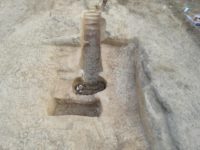 Archaeologists have completed the excavation of the 4th century B.C. Etruscan tomb discovered last year in Aleria, Corsica, and it is an even richer archaeological motherlode than initial reports suggested. Studies of the grave furnishings have already begun and will shed new light on Etruscan funerary customs in Corsica.
Archaeologists have completed the excavation of the 4th century B.C. Etruscan tomb discovered last year in Aleria, Corsica, and it is an even richer archaeological motherlode than initial reports suggested. Studies of the grave furnishings have already begun and will shed new light on Etruscan funerary customs in Corsica.
The discovery of the exceptional hypogeum tomb of an elite Etruscan was first announced by France’s National Institute for Preventive 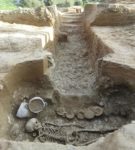 Archaeological Research (INRAP) in March, 2019. The ceiling of the tomb had collapsed onto the burial chamber, so the team had to dig from the top down until they hit proverbial paydirt. At the time of the announcement, they had gotten down to the burial chamber, exposing about 15 pottery vessels, a bronze mirror and a skull. By mid-April, the team had unearthed the full burial chamber.
Archaeological Research (INRAP) in March, 2019. The ceiling of the tomb had collapsed onto the burial chamber, so the team had to dig from the top down until they hit proverbial paydirt. At the time of the announcement, they had gotten down to the burial chamber, exposing about 15 pottery vessels, a bronze mirror and a skull. By mid-April, the team had unearthed the full burial chamber.
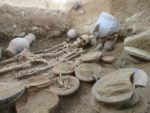 The deceased was found in a supine position, the head tilted to the left with arms alongside the body. The jewelry suggests she was female, as she was wearing gold earrings. She also wore two gold and copper finger rings. The body was surrounded with 40 ceramic vessels. To the right of her head were two large skyphoi (drinking vases with large handles on each side) and on the left side a small aryballos vessel. Along her right leg were found another skyphos and three oenochoai (wine jugs) decorated with female figures. These were all of local manufacture.
The deceased was found in a supine position, the head tilted to the left with arms alongside the body. The jewelry suggests she was female, as she was wearing gold earrings. She also wore two gold and copper finger rings. The body was surrounded with 40 ceramic vessels. To the right of her head were two large skyphoi (drinking vases with large handles on each side) and on the left side a small aryballos vessel. Along her right leg were found another skyphos and three oenochoai (wine jugs) decorated with female figures. These were all of local manufacture.
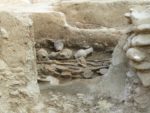 Two pottery alabastrons (a small perfume or oil vessel) were placed on her feet and next to them a group of small cups painted black, two bronze mirrors and an askos (vessel with one or two spouts on top for pouring liquids). Along the left side of the woman were a dozen cups of different shapes and sizes, including one in the shape of a head.
Two pottery alabastrons (a small perfume or oil vessel) were placed on her feet and next to them a group of small cups painted black, two bronze mirrors and an askos (vessel with one or two spouts on top for pouring liquids). Along the left side of the woman were a dozen cups of different shapes and sizes, including one in the shape of a head.
When excavations ended in April 2019, the team had recovered more than 200 artifacts, the skeletal remains of the deceased and skeletal remains from animals left in vessels. To ensure their preservation, the objects were only just released from the soil to be sent to laboratory for full cleaning, 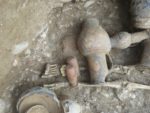 documentation and conservation. The painted pottery made in Etruria is particularly fragile because it was never fired. Unlike the black and red glazes typical of Greek pottery, the paint, especially the white used to highlight, can easily be damaged by even the mildest abrasion (like cleaning dirt off the surface). Conservators protected the paint by fixing it with an adhesive made from the swim bladder of a sturgeon, a natural glue that, unlike the acrylics often used, is completely reversible.
documentation and conservation. The painted pottery made in Etruria is particularly fragile because it was never fired. Unlike the black and red glazes typical of Greek pottery, the paint, especially the white used to highlight, can easily be damaged by even the mildest abrasion (like cleaning dirt off the surface). Conservators protected the paint by fixing it with an adhesive made from the swim bladder of a sturgeon, a natural glue that, unlike the acrylics often used, is completely reversible.
In the laboratory, the vessels were thoroughly excavated, cleaned and stabilized. Conservators discovered some surprises during the process, elements that could not be detected during the field excavation. Using a sophisticated CT scan technique called tomodensitometry, the objects were X-rayed in 360 degrees and the images reconstructed in 3D. This scan can see through dense clusters of artifacts and even reveal details about the method of manufacture.
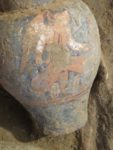 Twenty-two of the recovered objects were scanned. One of the skyphoi was found to contain a cup, likely used in a funerary ritual. A group of vases believed to have been deposited inside a now-decomposed woven basket, include a cup containing a small bronze ring. Four other such rings were found nearby and are believed to have been part of the basket. One of the alabastrons contains a metal rod, likely a perfume or ointment applicator stick. Engraved images on the back of mirrors depicts women holding such a stick in one hand and an alabastron in the other.
Twenty-two of the recovered objects were scanned. One of the skyphoi was found to contain a cup, likely used in a funerary ritual. A group of vases believed to have been deposited inside a now-decomposed woven basket, include a cup containing a small bronze ring. Four other such rings were found nearby and are believed to have been part of the basket. One of the alabastrons contains a metal rod, likely a perfume or ointment applicator stick. Engraved images on the back of mirrors depicts women holding such a stick in one hand and an alabastron in the other.
Next on the conservation agenda are the two bronze mirrors with bone handles. They have suffered significant damage over the millennia. Conservators will study them next, hoping to decipher any images carved on the non-reflective surface.